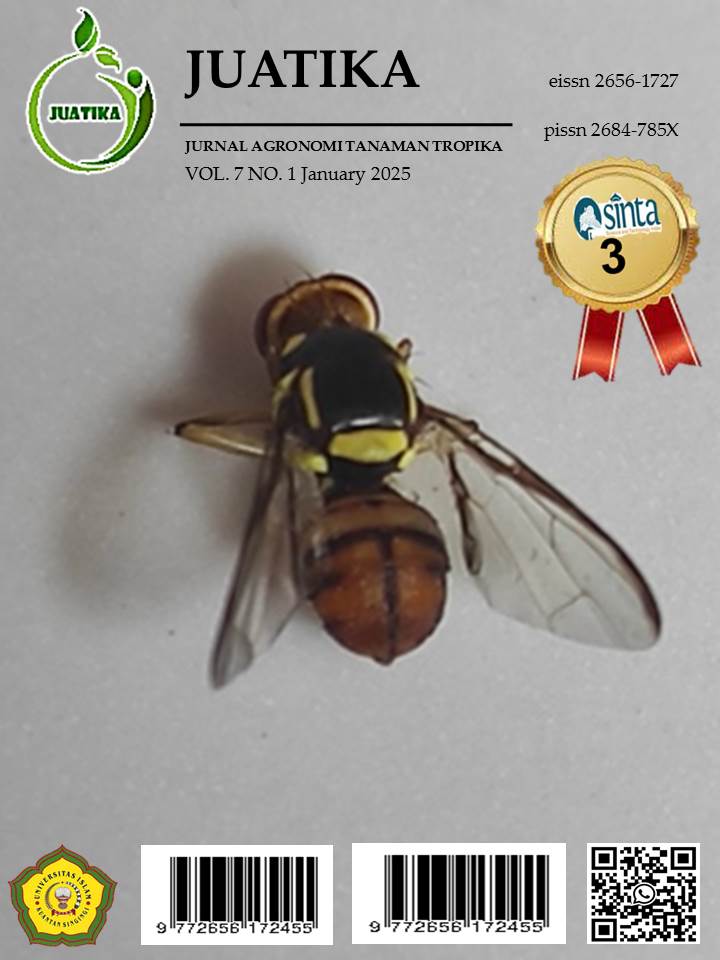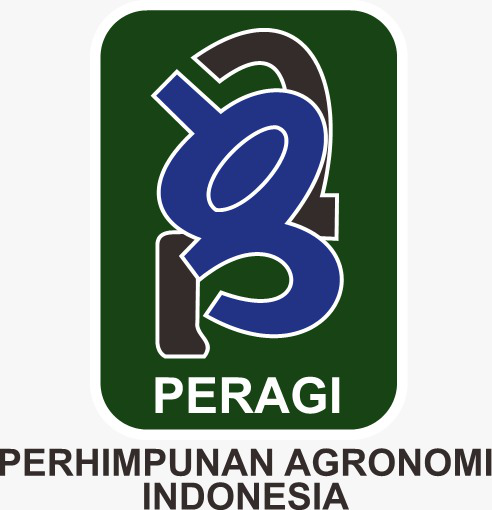Identification and Diversity of Mycorrhizae in Several Rhizospheres of Plant Vegetation in Ultisol Land
Abstract
The poor fertility of ultisol soil hinders the cultivation of food, horticultural crops, and plantation crop nurseries, leading to the abandonment of many lands. Low fertility and productivity levels and high solubility of Al, Mn, and Fe characterize ultisol soil. One effective method to enhance soil properties is by utilizing arbuscular mycorrhiza. Arbuscular Mycorrhizal Fungi (AMF) play a crucial role in improving nutrient and water absorption, thereby enhancing the growth potential of AMF-infected roots and plants. This study aims to identify the types and diversity of mycorrhizae present in the rhizosphere of plants growing in Ultisol soil. The study employed an exploratory approach involving the collection of soil and plant samples, analysing soil, and identifying Arbuscular Mycorrhizal Fungi (AMF) in Ultisol vegetation. The results revealed the presence of AMF in the rhizospheres of various plant species, including Seduduk, Harendong, Kirinyuh, Alang-Alang, and Paku Resam. Three mycorrhizal genera were identified, namely Glomus, Acaulospora, and Gigaspora.
Downloads
References
Arifin, A. J., Prasetya, B., & Kurniawan, S. (2020). Keragaman jenis dan populasi mikoriza arbuskula dalam berbagai kelompok umur pinus tumpangsari kopi di UB Forest. Jurnal Tanah dan Sumberdaya Lahan, 8(1), 9–17. https://doi.org/10.21776/ub.jtsl.2021.008.1.2
Armansyah, Herawati, N., & Kristina, N. (2019). Keanekaragaman fungi mikoriza arbuskula (FMA) di rizosfer tanaman bengkuang (Pachyrizhus erosus (L.) Mrb.) pada berbagai tipe rotasi pertanaman. Jurnal Agroteknologi Universitas Andalas, 3(1), 8–14.
Brundrett, M. (2004). Diversity and classification of mycorrhizal associations. Biological Reviews, 79, 473–495.
Damaru. (2019). Alang-alang. Makalah Ekologi Tumbuhan. Universitas Sumatera Utara.
Darlita, R. D., Joy, B., & Sudirja, R. (2017). Analisis beberapa sifat kimia tanah terhadap peningkatan produksi kelapa sawit pada tanah pasir di perkebunan kelapa sawit Selangkun. Agrikultura, 28(1), 15–20. https://doi.org/10.24198/agrikultura.v28i1.12294
Fianis, D. (2007). Morfologi dan klasifikasi tanah. Padang: Fakultas Pertanian Universitas Andalas.
INVAM. (2021). Taxonomy. Retrieved from http://fungi.invam.wvu.edu/
Kurnia, G., & S. H. L. (2019). Identifikasi dan karakterisasi mikoriza pada tegakan nyatoh (Palaquium sp.). Jurnal Tanah dan Sumberdaya Lahan, 15(1), 51–57.
Lica, E. N. L., Matinahoru, J. M., & Hadijah, M. H. (2022). Eksplorasi fungi mikoriza arbuskula (FMA) pada rizosfer pohon samama (Anthocephalus macrophyllus (Roxb.) Havil). Makila, 16(1), 31–43. https://doi.org/10.30598/makila.v16i1.5232
Maya Sari, M., Siregar, A., Walida, H., Ainy Dalimunthe, B., & Hariyati Adam, D. (2024). Study of soil biological properties in producing plants and immature plants of oil palm in Aek Nabara Utara Plantation PTPN III. Jurnal Agronomi Tanaman Tropika (Juatika, 6(1), 64–71. https://doi.org/10.36378/juatika.v6i1.3412
Opanida, D., Deslita, D., Refani, D. J., & Fakri, D. (2020). Keberadaan fungi mikoriza arbuskular (FMA) pada famili Fabaceae di kawasan Deudap Pulo Aceh Kabupaten Aceh Besar. Prosiding Nasional BIOTIK, 341–346. https://jurnal.ar-raniry.ac.id/index.php/PBiotik/article/view/9660/5442
Pelu, A. D., & Djarami, J. (2021). Studi farmakognostik tanaman harendong bulu (Clidemia hirta) asal Maluku. JUMANTIK (Jurnal Ilmiah Penelitian Kesehatan, 6(4), 314–320.
Rosendahl, S. (2008). Communities, populations, and individuals of arbuscular mycorrhizal fungi. New Phytologist, 178, 253–266.
Sandoval, W. A., & Millwood, K. A. (2014). The quality of students’ use of evidence in written scientific explanations. Cognition and Instruction, 23(1), 23–55.
Schüssler, A., & Walker, C. (2010). The Glomeromycota: A species list with new families and new genera. Retrieved from http://amf-phylogency.com
Suryana. (2009). Sebaran dan keanekaragaman jenis tumbuhan paku. Jurnal Ilmu Pendidikan, 15(1), 13–15.
Syahputra, E., Fauzi, & Razali. (2015). Karakteristik sifat kimia dan fisik subgrup tanah Ultisol di wilayah Sumatera Utara. Jurnal Agroekoteknologi, 4(1), 1976–1803. https://repositori.usu.ac.id/handle/123456789/52308
Tuheteru, F. D., & H. (2012). Pertumbuhan dan biomassa Albizia saponaria yang diinokulasi fungi arbuskula mikoriza lokal Sulawesi Tenggara. Silvikultur Tropika - Journal of Tropical Silviculture Science and Technology, 2(3), 143–148.
Veldkamp, E., Schmidt, M., Powers, J. S., & Corre, M. D. (2020). Deforestation and reforestation impacts on soils in the tropics. Nature Reviews Earth & Environment, 1–16.
Yakop, F., Taha, H., & Shivanand, P. (2019). Isolation of fungi from various habitats and their possible bioremediation. Current Science, 116(5), 733–740. https://doi.org/10.18520/cs/v116/i5/733-740
Yuliana, S., & Lekitoo, K. (2018). Jenis-jenis tumbuhan asing invasif di Taman Wisata Alam Gunung Meja Manokwari, Papua Barat (Invasive Plant Species at Gunung Meja Recreational Park, Manokwari West Papua). Jurnal Penelitian Kehutanan Faloak, 2(2), 89–102. https://doi.org/10.20886/jpkf.2018.2.2.89-102
Zebua, A. C. (2024). Application of FMA on soil chemical properties in oil palm (Elaeis guineensis Jacq.) plants. Jurnal Agronomi Tanaman Tropika (Juatika), 6(3).
Copyright (c) 2025 Rahmad, Aprizal Zainal, Aswaldi Anwar

This work is licensed under a Creative Commons Attribution 4.0 International License.
Authors who publish with Jurnal Agronomi Tanaman Tropika (JUATIKA) agree to the following terms:
Authors retain copyright and grant the Jurnal Agronomi Tanaman Tropika (JUATIKA) right of first publication with the work simultaneously licensed under a Creative Commons Attribution License (CC BY 4.0) that allows others to share (copy and redistribute the material in any medium or format) and adapt (remix, transform, and build upon the material for any purpose, even commercially) with an acknowledgment of the work's authorship and initial publication in Jurnal Agronomi Tanaman Tropika (JUATIKA).
Authors are able to enter into separate, additional contractual arrangements for the non-exclusive distribution of the journal's published version of the work (e.g., post it to an institutional repository or publish it in a book), with an acknowledgment of its initial publication in Jurnal Agronomi Tanaman Tropika (JUATIKA). Authors are permitted and encouraged to post their work online (e.g., in institutional repositories or on their website) prior to and during the submission process, as it can lead to productive exchanges, as well as earlier and greater citation of published work.







 More Information
More Information



